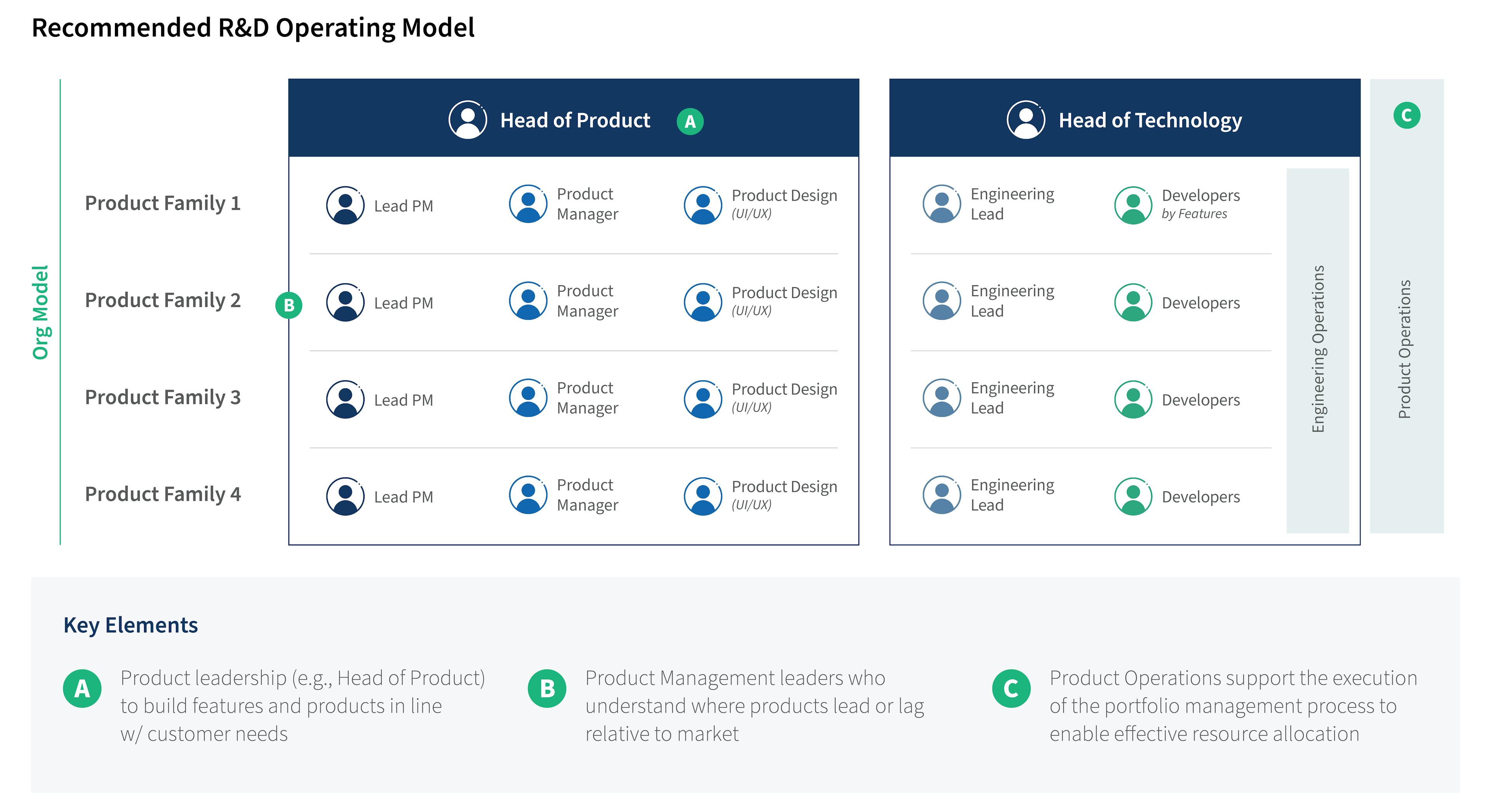Product Portfolio and R&D Effectiveness: Maximizing Value
Product Portfolio and R&D Effectiveness: Maximizing Value
In the current, uncertain macro environment, it is crucial for technology firms to boost R&D (product and engineering) productivity to deliver innovation and customer value sustainably. This is a top priority for CTOs, CPOs, finance leaders and investors, since R&D spending is one of the major items in a P&L.
Effective management of R&D expenditure with a customer-focused mindset is vital for the long-term success of a business, enabling it to outperform competitors and remain relevant in the market.
At FTI Delta, we have collaborated with R&D departments of various sizes, ranging from small, fast-growing organizations to well-established players. Through our experience, we have identified four key themes that increase value and productivity.
I. Independent Product and Engineering organizations create a healthy tension between customer-focused product development versus technical excellence, ultimately helping R&D create the highest customer value
Observation: R&D functions typically choose between a Product-led versus an Engineering-led organizational approach: In a Product-led R&D organization, product teams define the vision and roadmap, and prioritize features based on customer feedback and market needs. In contrast, Engineering-led R&D organizations focus on technical excellence and innovation, where the business model may rely on technological differentiation and superiority.
Solution: R&D organizations typically fall along the spectrum of the Product-led vs. Engineering-led operating model debate. While Product-led organizations are more effective at building features and products in line with customer needs and Go-to-Market (GTM) teams, they risk neglecting technical debt and platform infrastructure improvements at the expense of focusing solely on customer needs. Conversely, Engineering-led organizations push the innovation envelope with sophisticated high-quality products, but these products risk not driving a strong ROI for the company, potentially lacking alignment with customer and market needs or commercial viability.
Technology firms need to find a balance between Product-led vs. Engineering-led models to create high-quality products aligned to customer needs. Product teams need to be out in the market talking to customers, understanding what competitors are doing and communicating with GTM teams to ensure a robust understanding of where products lead or lag and areas of opportunity. Engineering teams should build scalable and robust platforms that can support Product’s efforts while appropriately managing technical debt. At FTI Delta, we have often helped firms establish a strong Product organization (with a CPO as a peer of the CTO) to create a healthy tension between external (customer, market) and internal (scalability, stability) needs. We have also assisted these companies in establishing a governance process that prioritizes activities by assessing competitor actions and market expansion, led by an ROI-focused Product Council, which includes stakeholders from Product, Engineering, Sales, Marketing and Finance.
In successful R&D organizations, the roadmap must align with GTM plans, be validated by market data and customer input, and be supported by a business case for optimal resource allocation and disciplined investment. This requires a robust portfolio management approach, overseen and closely monitored by the Product Council. The following themes outline strategies to avoid pitfalls and maximize value in R&D organizations.

II. The R&D roadmap is integrated with the Go-to-Market roadmap to provide stronger input for the Annual Operating Plan (AOP) and Long-Range Plan (LRP) while also enhancing cross-sell/upsell potential
Observation: R&D spending often lacks alignment with the business goals of the Sales and Marketing organization and does not consider market inputs. Additionally, there may be occasional uncertainty as to how R&D spending directly contributes to short-term and long-term value capture.
Solution: To improve collaboration and enhance revenue projections, integrate input from Sales and Marketing teams into the R&D roadmap, as well as market growth rates, competitive information and customer input. These inputs can validate R&D initiatives and incorporate R&D-driven sales projections into sales forecasts for the short-term and future quarters. This increases confidence in the revenue and cost forecasts used to establish quarterly targets for the AOP and LRP.
Cross-functional collaboration also facilitates the integration of customer insights from the Sales and Marketing teams into the R&D roadmap. It allows the Sales teams to identify any gaps, missed opportunities or misalignments in R&D plans, as well as validate whether customers will buy current or future products. For instance, Sales and Marketing can help identify product platforms where there is strong customer engagement, steering R&D away from potentially focusing on platforms & features with lower value-add. The resulting integrated roadmap can thus enhance upselling, cross-selling and renewal rates, helping to drive sales targets while promoting greater accountability from both R&D and GTM teams.
III. R&D initiatives are prioritized at the product portfolio level, with a strong emphasis on the business case
Observation: In an Agile development environment, business cases or ROI estimations are often overlooked, as they are seen as hindrances to faster delivery and continuous development. The lack of prioritization and decision-making based on market-anchored business cases can lead to inefficient allocation of R&D resources, impacting overall business goals.
Solution: By emphasizing R&D business cases with a strong link to market and customer dynamics, organizations can confidently prioritize projects and discuss affordability using financial data. In our experience, creating effective business cases does not have to hinder product development timelines or creativity. It can begin with fundamental information such as target customers and average revenue, establishing a revenue foundation that can be validated against market trends in collaboration with Sales and Marketing teams. For instance, assumptions on revenue growth that drive business cases need to have sufficient justification as to why the company can outgrow the market and take market share.
After validating the financials of the business case with a cross-functional stakeholder group, informed prioritization and resource allocation decisions can be made. For instance, a software product positioned within a slow-growing segment should have lower R&D spend intensity compared to products with higher revenue growth profiles or that enable market share growth.

IV. The R&D portfolio is overseen by a Product Council, which sets clear Key Performance Indicators (KPIs) for effective management
Observation: Measuring and improving R&D productivity to enhance the overall effectiveness of the R&D portfolio can be challenging. This is especially true when dealing with competing R&D needs across different business lines, inconsistent metrics for tracking effectiveness, and the lack of a structured governance framework to facilitate decisive actions.
Solution: Create a Product Council tasked with implementing the strategic themes defined by the executive team. This cross-functional governance body will have the authority to prioritize initiatives, allocate budgets, monitor progress and ensure initiatives align with strategic and financial goals. Product Council decision-making requires support from an effective Product Operations team to guarantee a single source of truth and minimum standards for data quality.
Furthermore, establish specific and regularly reported financial, quality, reliability and productivity KPIs at the product or product group level. These metrics should be relevant to the corresponding management layer and provide support for the roles and decisions made within that layer. This approach will enable the organization to quickly identify and address any issues through a comprehensive dashboard that provides a unified view of relevant metrics.
At FTI Delta, our unique approach has been extensively honed and consistently delivers significant improvements in R&D accountability, growth execution and cost discipline. We leverage our decades of experience to validate and optimize R&D strategies throughout the entire product life cycle. Our team combines in-depth functional knowledge in software, SaaS and technology with deep industry expertise, ensuring sustainable and effective solutions.
Authors:
Harvind Raman, Senior Managing Director
Diego Gamboa, Managing Director
Louis Segalini, Senior Director
The views expressed herein are those of the author(s) The views expressed herein are those of the author(s) and not necessarily the views of FTI Consulting, Inc., its management, its subsidiaries, its affiliates, or its other professionals.
FTI Consulting, Inc., including its subsidiaries and affiliates, is a consulting firm and is not a certified public accounting firm or a law firm.
FTI Consulting is an independent global business advisory firm dedicated to helping organizations manage change, mitigate risk and resolve disputes: financial, legal, operational, political & regulatory, reputational and transactional. FTI Consulting professionals, located in all major business centers throughout the world, work closely with clients to anticipate, illuminate and overcome complex business challenges and opportunities.
©2023 FTI Consulting, Inc. All rights reserved. fticonsulting.com
